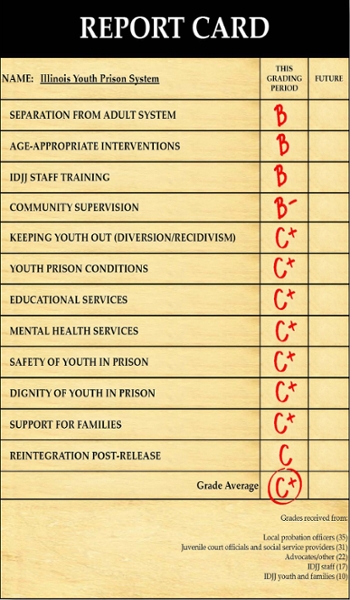Children in Custody

During the past decade, reforms of the juvenile justice system in Illinois have resulted in a dramatic reduction in the number of youth locked up in Illinois prisons. While these changes are a step in the right direction, more work is needed to develop approaches to juvenile justice that are truly conducive to community safety and positive youth development.
- Incarceration is not an evidence-based response to youthful offending, and does not make communities safer.
- Even at their best, large prison-like settings are unable to provide the holistic support and rehabilitation that young people need—especially those at highest risk.
- Research shows that most youth, including those involved in the most serious offenses, age out of these behaviors—while even brief experiences in prison or detention can result in poorer outcomes, including increased risk of incarceration as adults.
- Developing community supports for youth and ensuring that they are equally accessible is critical to the safety of both youth and communities.
In 2018, the CFJC launched the series Community Safety & the Future of Illinois’ Youth Prisons, to provide information and in-depth analysis to stakeholders and to help inform the development and continued improvement of the state’s juvenile justice system. The series is the culmination of many years of research, extensive surveys and interviews, and a comprehensive review of research by academics and practitioners. Community Safety & the Future of Illinois’ Youth Prisons overviews the history and evolution of the Illinois Department of Juvenile Justice and explores the way in which factors such race, youth development, and community dynamics impact the treatment of youth in conflict with the law.
The series will conclude with a detailed set of recommendations, consistent with calls from researchers and practitioners nationwide, for a five-year plan to end Illinois’ use of large, adult-modeled prisons for youth and to expand alternatives to incarceration.
March 2018, Vol. 3, “The Costliest Choice: Economic Impact of Youth Incarceration,” reports Illinois has experienced a substantial increase in the state’s per capita youth prison costs and explains how Illinois could transition youth committed to state custody into settings that achieve better outcomes with fewer negative side effects than the incapacitation-driven youth prison model.
November 2020, Vol. 7, “Going Back Inside: Reflections,” Denzel Burke writes about the experience of going back inside the state’s prison system – the places where he spent five years of his youth.
November 2020, Vol. 8, “Imagination From Incarceration: Creative Convenings Inside Youth Prisons,” reports on CFJC’s more than 30 convenings of youth behind the walls of the state’s five youth prisons and additional convenings of discussions with staff and incarcerated adults who previously were held in youth prisons.
Illinois Youth Prisons Receive C+ Grade — Improvement Needed
 In a report card delivered to state legislators in December 2017, the Illinois Department of Juvenile Justice received a C+ grade with improvement needed.
In a report card delivered to state legislators in December 2017, the Illinois Department of Juvenile Justice received a C+ grade with improvement needed.
The report card is based on a survey of 150 juvenile system stakeholders, who were asked to evaluate DJJ's progress on 12 key points central to DJJ's mission.
"It is just one form of feedback, but is consistent with the other information we have gathered: according to many who are familiar with Illinois youth prisons, while IDJJ has shown significant progress since its failing days as a subdivision of IDOC, it is still falling well short of both best practices and Illinois’ own standards, in many vital areas," Julie L. Biehl, CFJC Director, said in testimony to the Illinois House Appropriations - Public Safety Committee.
Biehl called for a 5-year plan to eliminate large-scale prisons. “Within five years, no young person should be incarcerated due to a lack of community services, supervision, or support, and every youth who is still committed to state custody should be held in a small, local, therapeutic setting," Biehl said.
Youth Justice Community Think Tanks
Community input is very important to us. To elevate the voices of youth and families directly impacted by the juvenile justice system, CFJC will partner this year with local organizations to conduct a series of community focus group “think tanks” in the Illinois counties that send the most children to prison. In small groups, we will discuss opinions about the current youth justice system and recommendations as to what future models may work best in Illinois to keep communities safe. These think tanks will help us to create a policy blueprint for the transformation of the juvenile justice system over the next decade. Please view our discussion questions.

